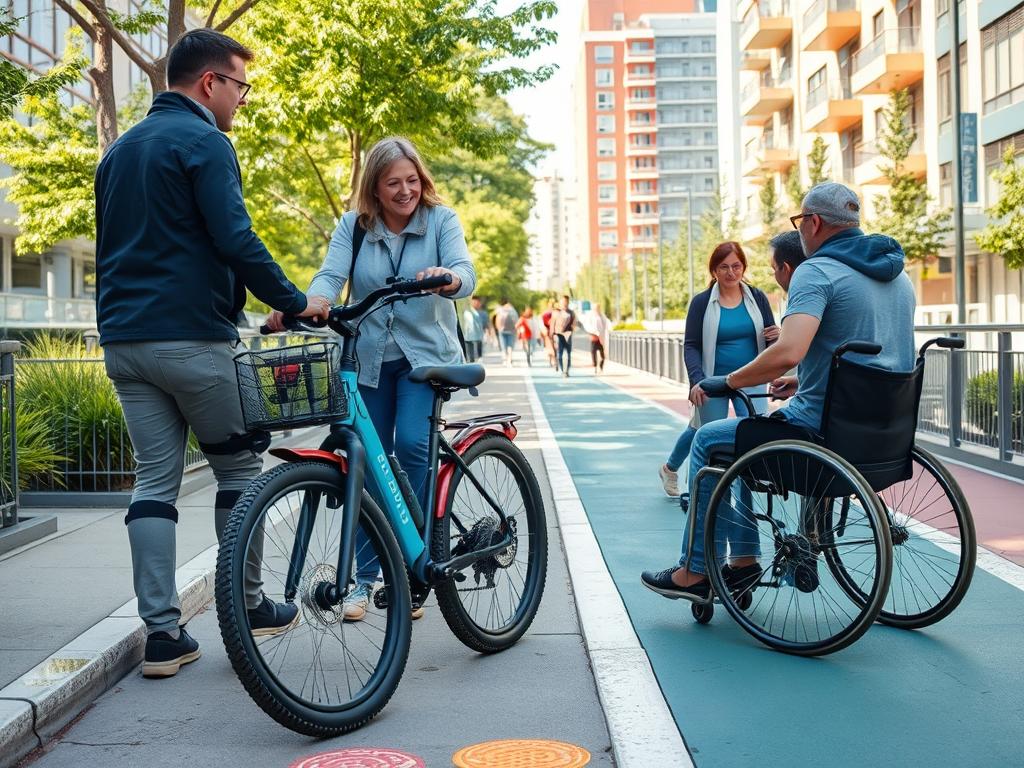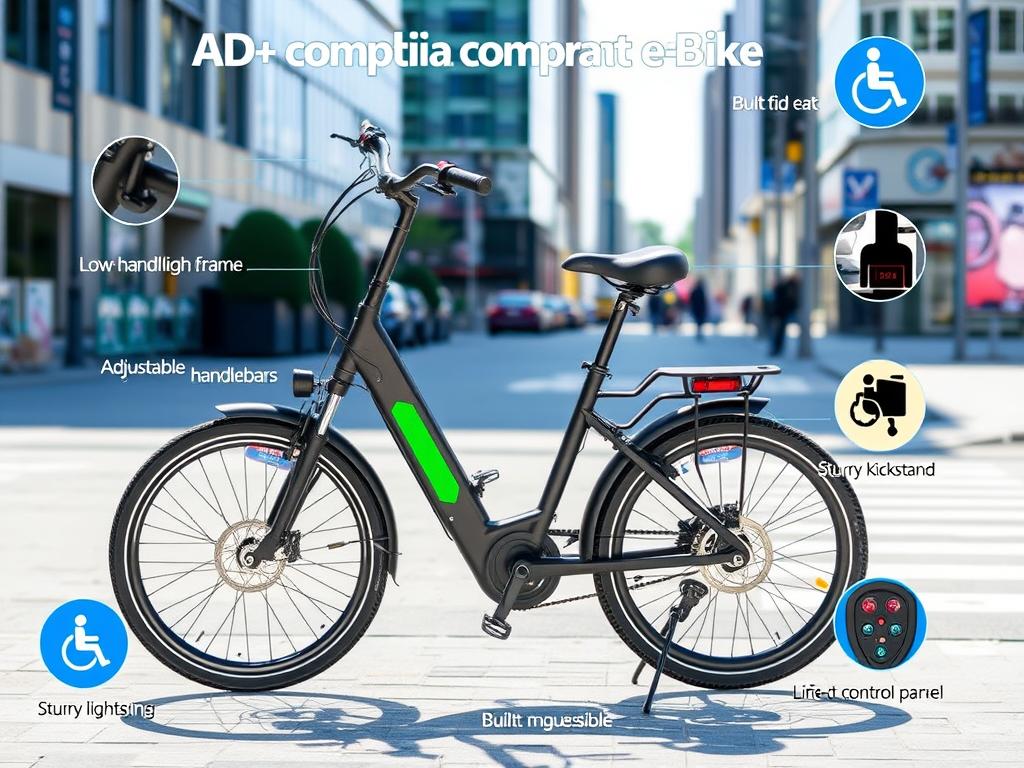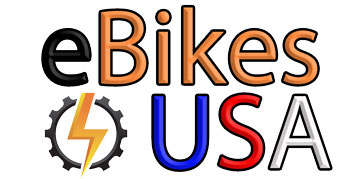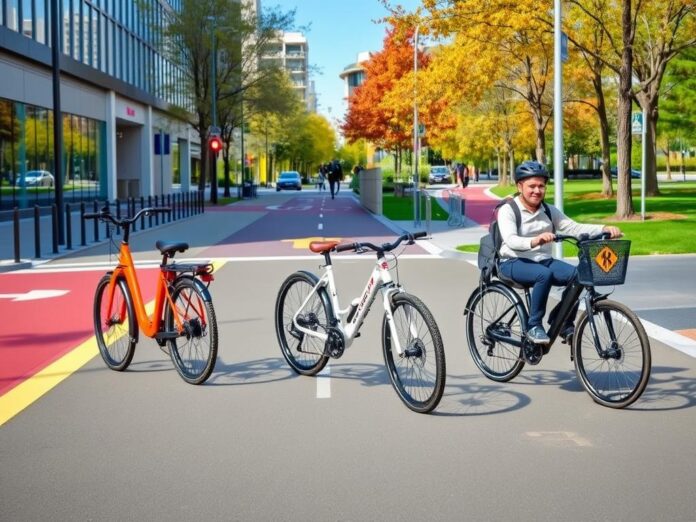The electric bike market is growing fast, offering new ways to get around. But, it’s also shown how important it is to make sure everyone can use these bikes. The Americans with Disabilities Act (ADA) ensures people with disabilities can use eBikes in public places.
Ensuring eBikes follow ADA rules is key for accessible transportation and mobility for all. The ADA says businesses and public places must let people with disabilities use eBikes. There are some exceptions for safety reasons.
Key Takeaways:
- ADA compliance ensures accessibility and inclusivity for eBike riders with disabilities.
- The ADA requires covered entities to allow the use of power-driven mobility devices, including eBikes, with some exceptions based on safety concerns.
- Regulations for eBikes vary significantly across different states, creating confusion for both riders and manufacturers.
- Understanding ADA compliance is crucial for eBike manufacturers and retailers to ensure their products and services are accessible and inclusive.
- Adhering to ADA guidelines can help eBike businesses expand their customer base and avoid potential legal consequences.
Understanding the ADA: What It Is and Its Purpose
The Americans with Disabilities Act (ADA) is a key civil rights law. It stops discrimination against people with disabilities. It makes sure everyone gets equal chances in jobs, public places, transport, government services, and phone calls.
The ADA has made a big difference. It makes sure places open to the public are wheelchair-friendly. This includes businesses and government buildings.
Definition of ADA
The ADA says a disability is a big problem with a major life activity. This includes many things like moving, seeing, thinking, and feeling. The law wants to make sure everyone can join in society.
Key Goals of the ADA
- Ensure equal opportunity and non-discrimination for individuals with disabilities
- Promote the integration and full participation of people with disabilities in the community
- Provide individuals with disabilities the same level of access and opportunity as those without disabilities
- Encourage the development of accessible products, services, and technologies
Impact on Accessibility
The ADA has made a big change in making places more accessible. It makes sure public places and businesses are wheelchair-friendly. This includes things like ramps and elevators.
The law also helps make things easier to use for everyone. This means things like websites and phones are easier for people with disabilities to use. It makes society more open to everyone.
| Mobility Device Category | Examples |
|---|---|
| Wheelchairs (manual or power-driven) and manually powered devices | Walkers, canes, crutches, braces |
| Other powered options | Golf carts, electronic personal assistance mobility devices (e.g., Segways), all-terrain vehicles (ATVs) |
The ADA’s push for accessibility has raised awareness. It has made society more inclusive. This is good for people with disabilities and makes cities better for everyone.

The Importance of ADA Compliance for eBikes
Using sustainable communities and empowering independence through eBikes means following legal requirements from the Americans with Disabilities Act (ADA). Following ADA rules for eBikes is key for reaching more people and avoiding legal trouble.
Promoting Inclusivity
ADA-compliant eBikes help people with disabilities get around and join in community activities. They can go to more places and paths. This makes eBike riding better for everyone, creating a more sustainable and empowering place for all.
Enhancing Market Reach
Following ADA rules lets eBike companies reach more people with disabilities. These users need reliable and easy-to-use transport. By serving this group, companies grow their customer base and stand out in the market.
Avoiding Legal Consequences
Not following ADA rules can lead to big fines and harm a company’s reputation. Staying on top of accessibility rules protects businesses from lawsuits. It also keeps them in line with changing legal requirements for power-driven mobility devices.
“Sustainable communities are built on the foundation of inclusivity and accessibility, and eBikes play a crucial role in empowering independence for all riders.”

Understanding the importance of ADA compliance helps eBike businesses. They can be leaders in sustainable communities and empowering independence. They also protect their businesses from legal issues and keep up with market changes.
Key Features of ADA-Compliant eBikes
ADA-compliant eBikes are key for accessible transport. They help people with different abilities. These bikes have special designs for comfort and ease of use.
Accessible Design Elements
These eBikes are designed for everyone. They have adjustable seats, handlebars, and pedals. This lets riders make the bike fit their needs.
The stable frame and low step-through make it easy to get on and off. Plus, smooth lubrication and good brakes make riding safe and fun.
User-Friendly Interfaces
These eBikes are easy to use for everyone. They have clear displays and big buttons. This helps riders with different abilities to use the bike easily.
Compatibility with Mobility Devices
These eBikes work well with wheelchairs and walkers. They have special attachments for easy use. This makes it easier for people to move around.
ADA-compliant eBikes show a big commitment to making transport accessible. They help people of all abilities enjoy riding. As more people want accessible transport, these eBikes will be very important.

The Benefits of ADA Compliance for Manufacturers
As the e-bike industry grows, manufacturers see the value of ADA. This step boosts their customer base and brand image. It also helps them follow the law.
Expanding Customer Base
ADA-compliant e-bikes reach a large, new market – people with disabilities. They want transport that’s accessible and empowering. This lets them join and help sustainable communities.
Improving Brand Reputation
Being ADA-compliant shows a brand cares about society. It builds trust and loyalty. It also makes a brand stand out as a leader in empowering independence.
Meeting Regulatory Requirements
Following ADA rules is not just right; it’s the law. Not doing so can lead to fines and lawsuits. By focusing on ADA, companies can avoid these issues and find new chances, like government deals.
ADA compliance is a win-win for e-bike makers. It grows their customer base, improves their image, and keeps them legal. This way, they lead in sustainable communities and make the future more inclusive.
Common Misconceptions About ADA Compliance
As eBikes become more popular, it’s important to clear up some common myths about the Americans with Disabilities Act (ADA). Many think the ADA only affects big businesses. But, it actually applies to all kinds of organizations, including those in the eBike world.
ADA Applies to Businesses of All Sizes
Many believe the ADA only targets big companies. But, the truth is, all businesses must follow the ADA’s rules. This includes small eBike makers and shops. They must make sure their products and services are open to people with disability rights.
Compliance is Not Too Expensive
Some think following the ADA is too costly. But, the costs of making eBikes accessible are often less than the benefits. By following ADA rules, businesses can reach more customers and avoid legal problems. This can make a business more inclusive and profitable.
eBikes are Not Exempt from ADA Regulations
Many believe eBikes are not covered by ADA rules. But, this is not true. eBikes, especially those used by people with disabilities, must meet ADA standards. Businesses in the eBike industry must make sure their products and services follow these rules.
By clearing up these myths, eBike companies can understand their ADA duties better. They can make sure their products and services are open to everyone. Following ADA rules not only makes businesses more inclusive. It also opens up new markets and helps avoid legal troubles.
Steps to Achieve ADA Compliance for Your eBike
Making your electric bicycle (eBike) accessible is key for everyone to enjoy riding. To meet ADA standards, follow these important steps:
Conduct an Accessibility Audit
First, check your eBike’s design and how it works. Look for any issues that might stop people with disabilities from using it. Focus on the bike’s design, controls, and how easy it is to use.
Engage with Accessibility Experts
Talk to experts in accessibility to learn about ADA rules for eBikes. They can offer advice on making your bike more accessible. Their insights will help you improve your eBike’s design.
Implement Necessary Changes
After your audit and expert advice, make the needed changes. This could mean changing the bike’s look, software, or how it works. Paying attention to every detail is important for ADA compliance.
By taking these steps, you make sure your accessible transportation meets the needs of all users. This promotes inclusive mobility and improves the eBike design experience for everyone.
“Accessibility is not just a legal requirement, but a moral and ethical obligation. It’s about creating a world where everyone can participate, explore, and thrive, regardless of their abilities.” – Accessibility Advocate
How Consumers Can Identify ADA-Compliant eBikes
As more people look for easy ways to get around, knowing how to find ADA-compliant eBikes is key. Understanding what makes an eBike ADA-compliant helps you choose wisely. This way, you can find eBikes that meet your needs for independence and accessibility.
Certifications and Labels
Spotting ADA-compliant eBikes is easy when you look for certifications or labels. These show the eBike meets important accessibility standards. Reputable makers often highlight these, so you can trust the eBike meets your needs.
Customer Reviews and Feedback
Customer reviews, especially from people with disabilities, offer great insights. They talk about how easy the eBike is to use and if it’s good for those with mobility issues. This feedback helps you understand the eBike’s real-world benefits.
Manufacturer Transparency
Good eBike makers are open about their ADA compliance. They share detailed info on their websites or in marketing materials. This info highlights the eBike’s features and design that help users with disabilities.
It’s important to know the laws about eBikes in your area. Different states have different rules. By focusing on ADA compliance, you can find the right eBikes for your needs. This improves your life and independence.
“At Electric Bike Technologies, we’re committed to providing sustainable and accessible electric mobility solutions that improve the lives of all our customers, including those with disabilities.”
The Future of eBikes and ADA Compliance
The future of eBikes and ADA compliance is looking bright. Trends in accessibility design are making eBikes more innovative and inclusive. As the eBike market grows, we can expect clearer and stronger ADA rules across states. This is great news for companies that focus on making their products accessible.
Trends in Accessibility Design
Accessibility is now a top priority for eBike makers. They’re adding features like adjustable seats and ergonomic handlebars. These changes help riders with different mobility needs enjoy their rides more.
The global eBike market is set to hit $119.72 billion by 2030. This growth shows how popular eBikes are becoming. Analysts say the lightweight eBike segment will grow by 7.7% each year from 2023 to 2028. This means we’ll see more eBikes that fit a wider range of riders.
Legislative Changes on the Horizon
As eBikes evolve, we’ll see new laws that make ADA compliance clearer. Projects like the California E-Bike Incentive Project show the need for accessible mobility. It offers vouchers for low-income Californians to buy eBikes.
Over 30 states have rules for electric bikes similar to regular bikes. But, some states like Massachusetts have special rules for certain eBikes. This shows we need more consistent rules across the country.
Potential Market Growth for Compliant eBikes
The focus on sustainable communities and inclusive mobility is good for eBike makers. The secondhand eBike market is growing fast. This means more people can afford eBikes, making them a better option for many.
Many countries offer subsidies and tax breaks for eBikes. This makes them more affordable and accessible. With more people learning about eBikes’ benefits, we can expect to see more ADA-compliant models in the future.
| Metric | Value | Projection |
|---|---|---|
| Global eBike Market Size | $119.72 billion | By 2030 |
| Lightweight eBike Segment CAGR | 7.7% | 2023-2028 |
| eMTB Market Size | $5.77 billion | Estimated in 2024 |
| eMTB Market Projected Size | $10.43 billion | By 2029 |
“The future of eBikes and ADA compliance looks promising, with trends in accessibility design leading to more innovative and inclusive eBike models.”
Resources for Further Information on ADA Compliance
If you want to learn more about ADA compliance for eBikes, there are many resources out there. The official ADA website (ADA.gov) has a wealth of information. It includes guidelines and rules for accessible transportation. Also, state transportation departments often have resources and guidance on ADA rules for public places and paths.
Nonprofit groups focused on disability rights and accessible transport are also great resources. Organizations like the National Disability Rights Network and the Disability Rights Education & Defense Fund fight for disability rights. They can share insights on how to follow ADA compliance best practices.
Online Courses and Workshops
There are online courses and workshops to help you understand ADA compliance better. These resources cover topics like accessible design, legal needs, and how to make eBikes ADA-compliant. By using these educational tools, you can keep up with ADA updates. This ensures your eBike products or services meet the required standards.






